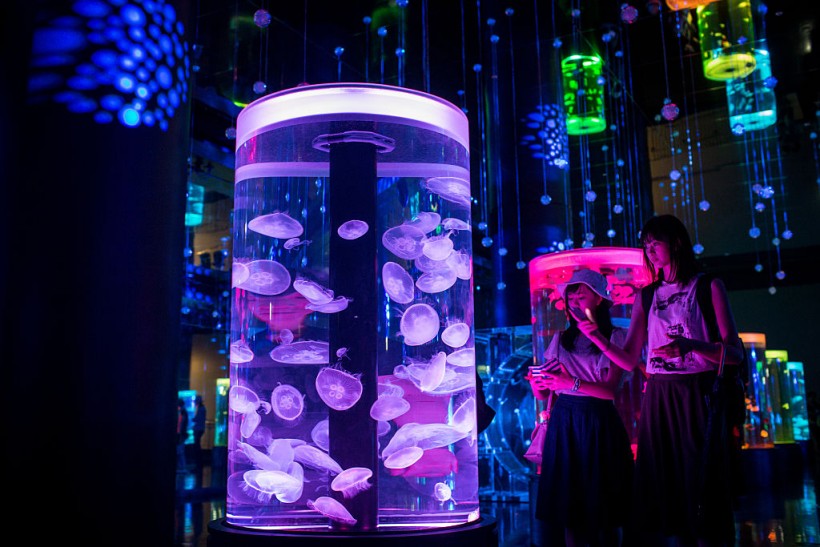Cnidocytes, stinging cells, might be a useful model for understanding the formation of new cell types, which has been a significant challenge in evolutionary biology.
Sea anemones, jellyfish, corrals, and hydrae, belong to the cnidaria phylum and feature specialized stinging cells called cnidocytes. These specialized cells developed by repurposing neurons passed down from pre-cnidarian ancestors; however, how they did so was unknown until recently.
To further understand the formation of different cell types, Biotechniques said Cornell University researchers examined the sea anemone called Nematostella vectensis.

TOKYO, JAPAN - JULY 15: People look at the Jellyfish display at the EPSON Aqua Park Shinagawa on July 15, 2015 in Tokyo, Japan. The EPSON Aqua Park Shinagawa, previously known as EPSON Shinagawa Aqua Stadium, reopened to the public on July 10, 2015 after an extensive renovation. The animal and fish displays have been enhanced with high-tech neon lights, touch screens and audiovisual shows.
Cnidocyte and Neuron Drive the Evolution of Biodiversity in Phylum Cnidaria
Cnidocytes developed from neurons identified in a pre-cnidarian ancestral species, according to a study headed by professor Leslie Babonis.
"These surprising results demonstrate how new genes acquire new functions to drive the evolution of biodiversity," Babonis said per Devdiscourse. "They suggest that co-option of ancestral cell types was an important source for new cell functions during the early evolution of animals," the researcher added.
One of the major issues in evolutionary biology, according to Babonis, is figuring out how specialized cell types, such as stinging cells, emerge. Cnidocytes or the singing cells are present in jellyfish and corals. While sea anemones have neurons.
Cnidocytes have been known to originate from a group of stem cells that give way to neurons (brain cells) for over a century, but until today, no one knew how those stem cells choose to generate a neuron or a cnidocyte.
Babonis believes that studying this mechanism in current cnidarians might offer information about how cnidocytes developed in the first place. Cnidocytes (Greek for "stinging nettle") are a kind of cell found in the phylum Cnidaria that may launch a poisonous barb or glob and shock prey or discourage attackers.
ALSO READ: Robotic Fish Made of Human Heart Muscle Swims For More Than 100 Days [Watch]
Cnidarians are the only creatures with cnidocytes, whereas neurons are found in many species, according to Babonis. Hence, she and her colleagues at the University of Florida's Whitney Lab for Marine Bioscience studied cnidarians, particularly sea anemones, to uncover how a neuron might be reprogrammed to form a new cell.
According to researchers, cnidocytes appear to be one of the clearest illustrations of how the birth of a new gene, which encodes a unique protein, might drive a new cell type development. These harpoons, researchers pointed out, are formed of a protein found exclusively in cnidarians.
The researchers demonstrated that cnidocytes form by turning off the expression of neuropeptide called RFamide in a subpopulation of developing neurons and repurposing those cells as cnidocytes using functional genomics in the starlet sea anemone Nematostella vectensis.
Poison Runs in the Cnidaria Phylum
According to ANI, the researchers discovered that a single cnidarian-specific regulatory gene controls both the brain function and the cnidocyte-specific features of those cells. Both neurons and cnidocytes are secretory cells that may expel material out of the cell, according to Babonis. Neuropeptides are proteins released by neurons that transmit data fast to neighboring cells. Poison-laced harpoons are secreted by cnidocytes.
It is the first research to establish that this logic exists in a cnidarian. Therefore this trait likely governs how cells differentiate from one another in the first multicellular creatures, according to Babonis.
Future research by Babonis and her group will look at how often this genetic off/on switch works in creating new cell types in animals. One research, for example, will look at whether a similar process drives the genesis of fresh skeleton-secreting cells in corals.
Researchers unveiled their study, "A novel regulatory gene promotes novel cell fate by suppressing ancestral fate in the sea anemone Nematostella vectensis," in the Proceedings of the National Academy of Sciences.
RELATED ARTICLE: Glowing Neurons: Genetically Modified Jellyfish Gives Light on How Human Minds Work
Check out more news and information on Animals in Science Times.














